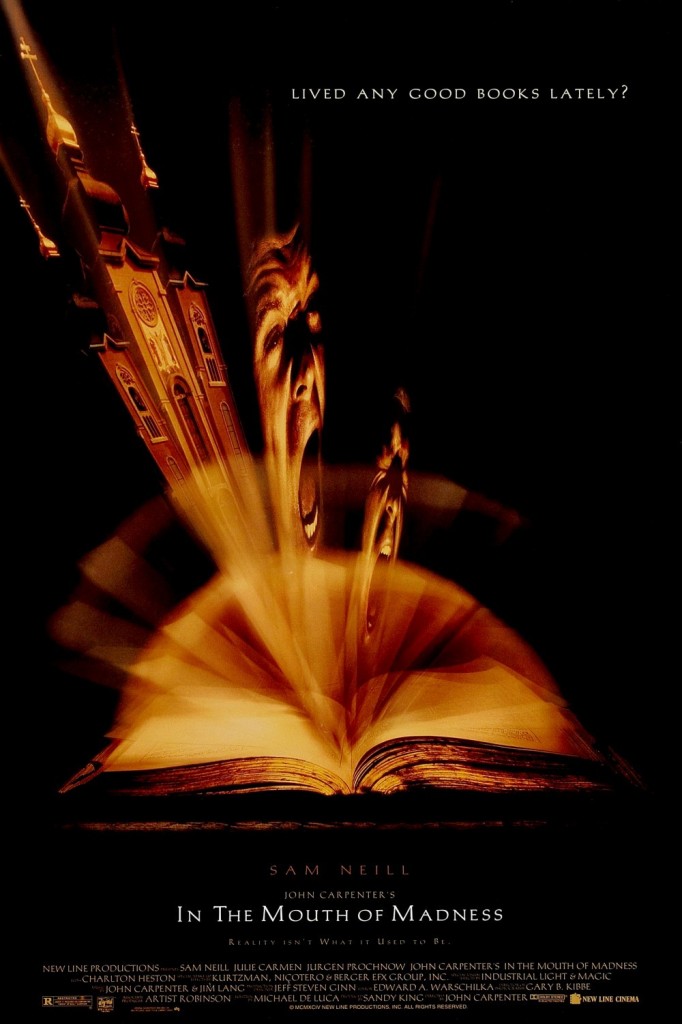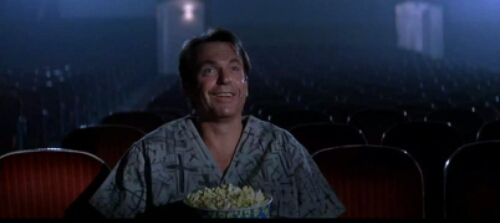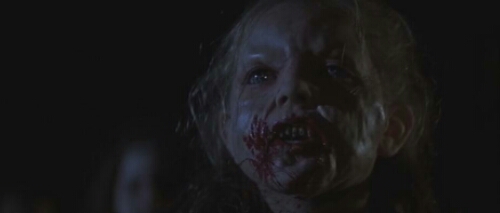This October, Deadshirt staff revisits some of our favorite horror movies from a variety of subgenres and breaks down what makes them so memorable, so clever, and so terrifying. Our final installment: John Carpenter’s Lovecraftian horror film In the Mouth of Madness.
The specific brand of cosmic horror that H.P. Lovecraft produced in the early-mid 20th century was in large part marked by unreliable first-person narrators spiraling deeper into insanity, and the fear they felt being aware of their lost grip on reality. While much of the terror in Lovecraft’s stories comes from looming creatures beyond human understanding, an equal amount finds its roots in the narrators’ self-doubt and confusion as their fundamental understanding of reality is shaken. That disoriented storytelling is, as you’d guess, hard to film.
But dammit if John Carpenter doesn’t knock it out of the park.
With In the Mouth of Madness, Carpenter, easily a master of horror in his own right, dissects the Lovecraftian horror story and reassembles it, using his own adept eye for filmic storytelling to stitch the pieces together into an excellent cosmic horror film.
First of all, Carpenter nails the “frame narrative from a madman–or perhaps the most sane person!” trope that’s so prevalent in Lovecraft, starting off with John Trent (Sam Neill) being dragged kicking and screaming into a padded cell.
John Trent himself is perhaps a reference to a story from Lovecraft-inspirer Robert Chambers’s “The King in Yellow,” nestled in with other fun bits of trivia like Arcane publishing house (not far from Lovecraft’s Arkham) and author Sutter Cane (perhaps a lost cousin of Robert E. Howard’s supernatural vanquisher of evil, Solomon Kane). Trent proves his Lovecraft protag cred beyond maybe-madness early on, by attempting to walk his doctor through the “standard” symptoms of paranoid schizophrenia in a clear attempt to both seek a “reasonable” outside opinion on his mental health and to cling to an empirical checklist that will help Trent himself decide if he thinks he’s had a break with reality, or if reality has had a break with him.
It doesn’t hurt his Lovecraft affinity that Trent’s an early-middle-aged white male professional whose job description includes uncovering facts, an heir to Lovecraft’s theoretical mathematicians and various -ologists.
Carpenter addresses the inherent distance of the film medium artfully and carefully, making up for cinema’s general inability (short of found footage, which I think we can all agree would have been terrible here) to mimic the Lovecraft favorite of “uncovered personal journals being published.” We get the first hints that Carpenter wants us to believe Madness’s world is our world during the opening credits, as jackets for a book bearing the film’s title are being mass-produced. It continues with a figurative wink at the camera when Neill moans from the confines of his straitjacket, “Oh no, not The Carpenters,” trying to drown out the band’s “We’ve Only Just Begun,” a probable reference to the director. Carpenter’s name is all over this thing, which feels janky on first watch-through but, once you see it’s a thread attempting to bind the world of the movie to the world where people know they’re watching a John Carpenter movie, it’s a momentary confusion you can forgive. Those threads start to pile up, starting with the aforementioned credits, then with the Carpenters comment, and culminating in one of the final scenes, in which we see Neill entering a theater door flanked by posters promoting In the Mouth of Madness, starring Jack Trent, directed by John Carpenter, and crediting the film’s actual production team.
As Trent makes his slow (or as slow as a ninety-minute film can allow) journey from hard-nosed, self-assured empiricist and cynic supreme to a quivering, howling puddle of insanity, Carpenter pulls reassuring truths out from Trent’s worldview, like a game of Jenga Carpenter’s planning to lose. But he doesn’t want to just yank one load-bearing tile out at the very beginning like my jerk neighbor used to growing up. Carpenter, like Lovecraft did before him, puts one weird thing in front of his protagonist after another, beginning with the mildly confusing, progressing to the actually disorienting, and then upshifting to the outright impossible.
Much of Lovecraft’s tile-pulling comes in the form of his narrators’ self-doubt and phrases of uncertainty around events. Carpenter does not have the luxury of a narrator, so he just brings the weird.
One recurring thread is a young boy who rides his bike past Trent and the maybe-non-existent Linda Styles’ (Julie Carmen, being aggressively Nineties Businesswoman Beautiful) car, seemingly aging significantly each time, only to appear, eyes completely clouded, hair a white shock, face riven by wrinkles and sagging, and riding head-on into the car. When Styles and Trent go to check on the impossibly old-looking man, he speaks with the voice of a child. Chilling. Weird. Perfect.
During this car ride, Styles and Trent discuss the meaning of subjective reality and reality by consensus, perfectly setting up Carpenter’s vision of the Elder Gods as almost thoughtforms, their return to our dimension hastened by believers. The scene lays the groundwork for Carpenter’s climax and, in a way, Neil Gaiman’s American Gods.
From there, as you’d expect, Carpenter whips out his Palette of the Gross and Weird and begins applying brushstrokes everywhere Trent goes, unabashedly making use of grotesque, bloody children and referential nods (beyond those discussed above, there is Trent and Styles’ stay at Pickman’s Inn, among others). Once Trent sees the townspeople storming the damned church (like, forsaken by God, not an expletive here) and watches them set upon by mangy, awful dogs and haunted by their own eerie, evil children, Carpenter’s strokes gain fervor. Everything that could be slimy, is. Tentacles galore. Axe murders, axe murders everywhere.
As Sutter Cane, cosmic horror writer extraordinaire, becomes more clearly defined as an actual supernatural and perhaps deity-level force, instead of just a recluse with delusions of grandeur, Carpenter makes sure to turn up the weird to 11. You thought axe murders were bad, did ya? Well now you’ve got sweating, bulging, sighing doors and sharp-teethed fetuses Voldemorting on the back of dudes’ heads.
And that is what makes this movie so fantastic, to me. It acknowledges that its source material preferred a much more staid, un-gross approach to unnerving its protagonist before its big horrifying reveal, but it also acknowledges that film is a visual medium, without access to many of the “easy” disorienting effects available to prose writers. So Carpenter drops in small shocks along the way, growing more and more discomforting, until we reach an orgy of practical effects that only a Carpenter film can pull off.
While the metatextual references and your-continuity-is-our-continuity nods don’t quite make the leap to “this could be real!” (mass violence in the name of Sutter Cane isn’t happening in our AU), they’re pretty cool, and you have to give Carpenter props for trying. It’s a level of commitment you don’t often see, and it does allow the movie to lean toward the same unease Lovecraft seeks with his narrators’ claims of their stories being notes or journals.
To me, In the Mouth of Madness is a far better treatment than I ever could have expected for the Lovecraft stories I love so much. And while that love of the source material, to which Carpenter nods so often in Madness, does bias me in its favor, I’d argue this is an excellent scary movie, guaranteed to scratch anyone’s insanity-and-the-grotesque itch, even if they’ve never read a word of Lovecraft. Also, I’m pretty sure it’s against the law to not watch at least one John Carpenter movie every October, so this information could save you from a hefty fine.
That wraps up our celebration of horror films this October. Make sure to check out the other installments of our Horror Month series!




